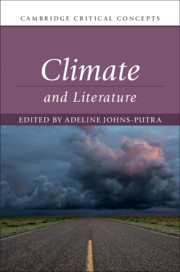Book contents
- Climate and Literature
- Cambridge Critical Concepts
- Climate and Literature
- Copyright page
- Contents
- Illustrations
- Contributors
- Acknowledgements
- Introduction
- Part I Origins
- Chapter 1 Literature, Climate, and Time: Between History and Story
- Chapter 2 Atmosphere as Setting, or, ‘Wuthering’ the Anthropocene
- Chapter 3 The Seasons
- Chapter 4 Climatic Agency in the Classical Age
- Chapter 5 Weathering the Storm: Adverse Climates in Medieval Literature
- Chapter 6 The Climate of Shakespeare: Four (or More) Forecasts
- Part II Evolution
- Part III Application
- Bibliography
- Index
Chapter 2 - Atmosphere as Setting, or, ‘Wuthering’ the Anthropocene
from Part I - Origins
Published online by Cambridge University Press: 31 July 2019
- Climate and Literature
- Cambridge Critical Concepts
- Climate and Literature
- Copyright page
- Contents
- Illustrations
- Contributors
- Acknowledgements
- Introduction
- Part I Origins
- Chapter 1 Literature, Climate, and Time: Between History and Story
- Chapter 2 Atmosphere as Setting, or, ‘Wuthering’ the Anthropocene
- Chapter 3 The Seasons
- Chapter 4 Climatic Agency in the Classical Age
- Chapter 5 Weathering the Storm: Adverse Climates in Medieval Literature
- Chapter 6 The Climate of Shakespeare: Four (or More) Forecasts
- Part II Evolution
- Part III Application
- Bibliography
- Index
Summary
Atmosphere is both a literal aspect of the Earth system and a formal property of literary texts. This chapter takes up that double-meaning of the term. Taking the description of atmospheric phenomena in literature seriously helps illustrate the expansive entanglement between climate and human history, revealing changing attitudes to climate across time. At the same time, attending to formal atmosphere helps illustrate literature’s capacity to mediate, and symptomatise, climatic history and its impacts upon culture in ways that extend beyond description to include character formation, book production, and textual studies, while also elevating the importance of setting as both physical location and formal property. The chapter also expands our consideration of setting to include sites of reading along with those of composition or narration. Utilising Emily Brontë’s Wuthering Heights as a case study, the chapter advocates a mode of reading that situates literary history within the history Earth system, which is to say the study of the planet as a single, interconnected whole.
- Type
- Chapter
- Information
- Climate and Literature , pp. 31 - 44Publisher: Cambridge University PressPrint publication year: 2019
- 1
- Cited by

